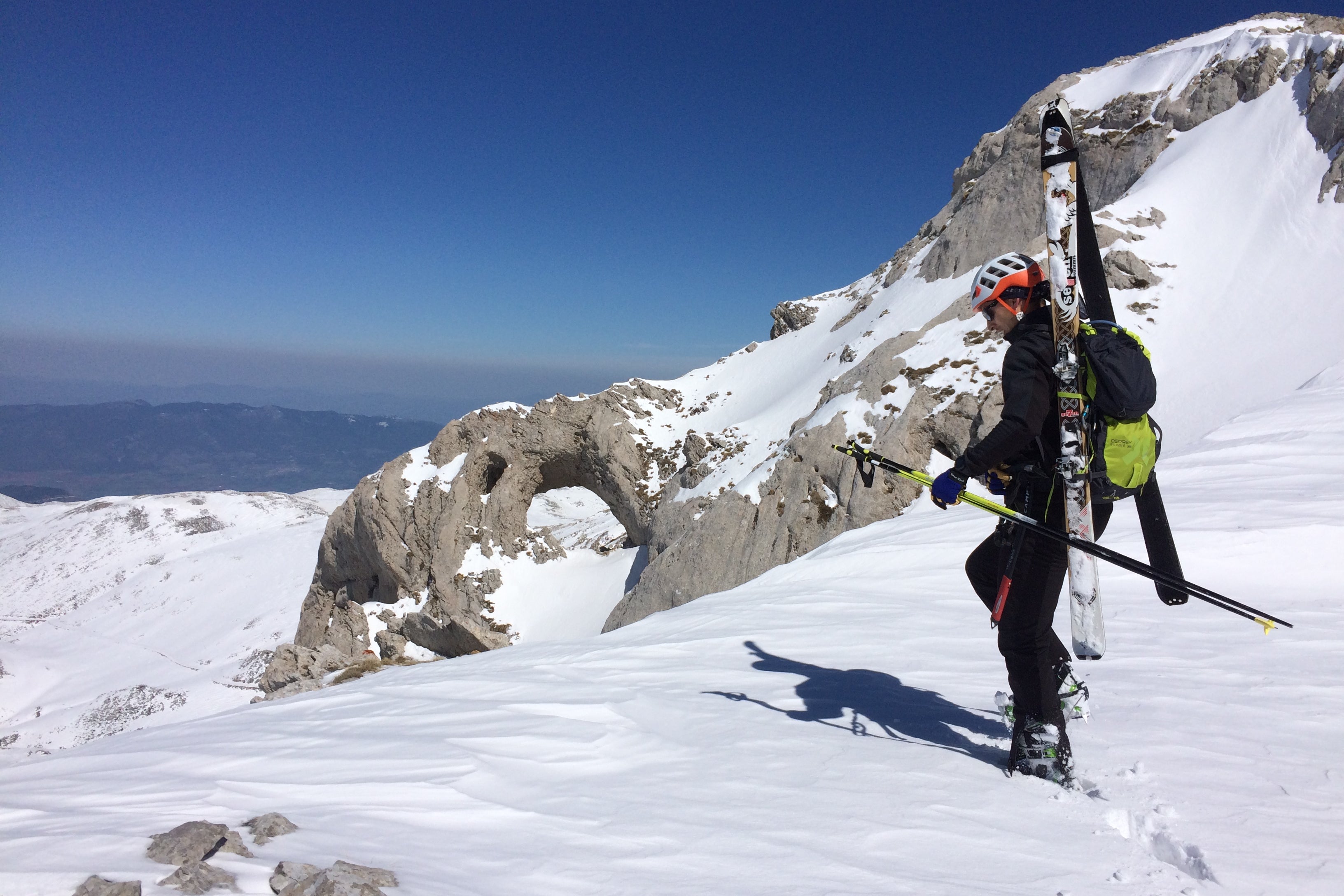
Fresh snow puffed under my heels like icing sugar, and pine trees glistened like Christmas baubles under skies the colour of faded denim. Apart from the twin-toed tracks of roe deer and the cross-hatched marks left by bird’s feet, the snow swept ahead of me in a pristine swathe. The joy of being the first to plant skis on this powder-soft terrain was akin to the thrill of discovering a new country – it occurred to me that for most tourists who come here for blue skies and golden-sand beaches, Greece in winter is a new country.
I arrived in the mountain town of Arachova on the ski bus from Athens. I was the only foreigner making the two-hour journey. “You Brits hate the bad weather, but we have sunshine all the time – we love rain and snow,” a fellow traveller joked.

Read more: Best hotels in Mykonos
“It’s a little-known fact that 80 per cent of Greece is made up of mountains and Olympos, our highest mountain, is nearly 3,000 metres high,” mountain guide Eleni Prablanc, who met me from the bus after the two-hour journey, told me. After a tour of Arachova’s amphitheatre, of cobbled alleys lined with slate-roofed houses gazing out over a smoke-wreathed valley, we headed for the slopes.
There are more than a dozen ski resorts in Greece. With 25 pistes suitable for all ability levels, the Parnassos Ski Centre near Arachova is one of the best. We swung by Kelaria, the jet-setter side of the mountain where crowds of Athenians in expensive winter wear lounged on sunbeds sipping cocktails, and then headed for the quieter slopes of Fterolaka. “We have lower slopes than the Alps, which means that there’s less chance of an avalanche,” Eleni told me as we set off.

Since it was a weekday, passes were only €11 (£9) and the slopes were sparsely populated. “Most Greeks come here on the weekend,” Eleni said as she dug me out of – yet another – snowdrift.
Tired and hungry after sunset, I wandered Arachova’s cobbled streets lined with rustic tavernas, whose caned chairs and wonky blue tables spilled out onto the snow-covered pavement. At Kaplani’s, near the town’s 19th-century clocktower, I sat by a crackling log fire listening to the plink-plonk of bouzouki music as I snaffled a plateful of meat-stuffed cabbage sarmades (the winter equivalent of vine-leaf dolmades), and downed punch-packed drams of rakomeli – the Greek equivalent of gluhwein, made with honey-infused white spirit raki. “You see? It’s just like Greece in summertime, only it’s winter,” the waiter joked as he presented me with the whopping €13 (£11) bill.
Read more: The best ski resorts for late season snow

Keen to experience more of Greece’s budget-friendly ski scene, I headed for Portaria and its ski resort, some three hours away in the foothills of Mount Pelion; it’s where Boris Johnson has his summer hideaway. Halfway to Portaria, I stopped off in Thermopylae. The narrow mountain pass where the Spartans made their legendary last stand against the Persians is better known by modern Greeks for the mineral-rich hot springs that thunder out of the ground here at around 39C. Joining locals, I frolicked for an hour in the steaming, sulphur-scented river as snowflakes swirled like confetti in the crisp, cold air.
Seven miles from Volos, where ferries leave for Mamma Mia! island Skopelos, the tiny mountain town of Portaria – with its steep paved streets and gushing waterfalls – is a popular base for snow-lovers heading for the Agriolefkes ski centre nearby.

Read more: How Turkey became an affordable skiing destination
Agriolefkes is much smaller than Mount Parnassos – it only has five chair lifts and eight slopes – but Panagiotis my mountain guide from local company Hike or Bike assured me that the pistes were in excellent condition, and a day pass was even cheaper than Mount Parnassos. After a breakfast at Valeni Hotel of hortopita pies stuffed with wild greens and custard-crammed galaktoboureko pastries, we headed for the slopes.
Strapping on touring skis, we went cross country, swishing for five hours over thick blankets of pristine snow while enjoying spectacular views of the Aegean Sea glittering far below – all without seeing another soul. Panagiotis told me about the legendary half-man, half-beast centaurs that are said to haunt these slopes. “We still believe in them here: we say that any negative natural phenomena, like a sudden change in the climate or weird weather conditions, is caused by them,” he told me.
Strolling through starlit streets to dinner that evening, Panagiotis pointed out the moss-carpeted ruins of the Mega Theoxenia hotel. “This was once the most luxurious hotel in the Balkans. It belonged to the Athanasaki family. They were Egyptiots – wealthy Greeks who lived in Egypt. It was burned down in 1944 by the Germans,” he said, crossing himself vigorously.
Read more: The ultimate food tour of Greece’s Peloponnese

At family-run taverna Kritsa we chowed down on meze snacks of tsitsiravla (pickled pistachio shoots) and grilled anchovies dipped in vinegar, followed by spicy meat-stuffed kremmydolmades. “Greece isn’t Avoriaz – it’s for people who prefer wilder places in winter,” said Panagiotis, slugging back his glass of Assyrtiko white from Pelion’s Patistis winery. “You could say it’s the Swiss Alps at half the price, only with far better food.”
How to do it
Heidi was a guest of Discover Greece. She stayed at Likoria Hotel, rooms from £65 per night and Valeni Boutique Hotel and Spa, rooms from £95 per night. Self-guided tours of Delphi from £11.20 by Clio Muse Tours.
For more information, visit discovergreece.com
When to go
The Greek ski season runs from December to March (or April in a good year). Visit the Snow Forecast website for individual resorts and their opening dates.
How to get there
Heidi flew with Aegean Air the country’s flag carrier, which operates direct flights to Athens from more than 100 destinations including Heathrow, Luton and Stansted.







